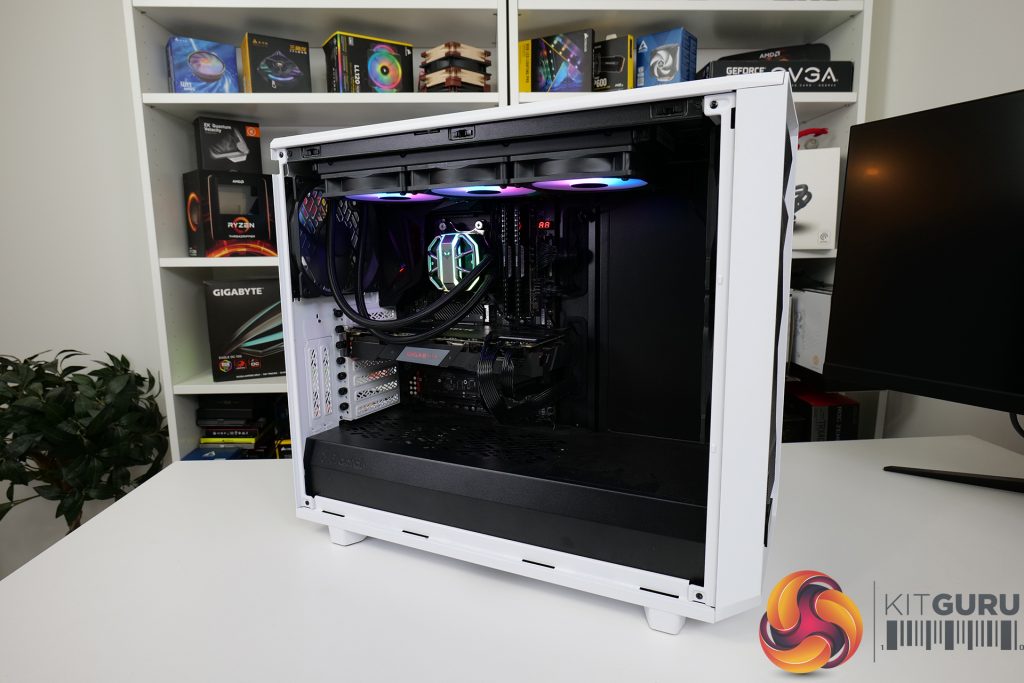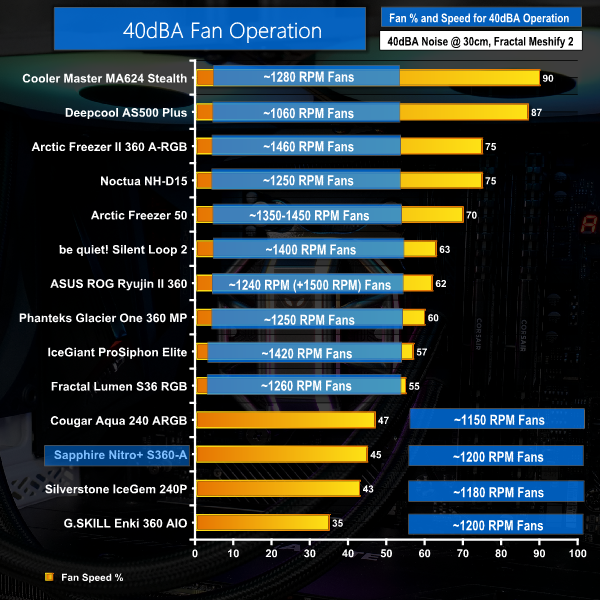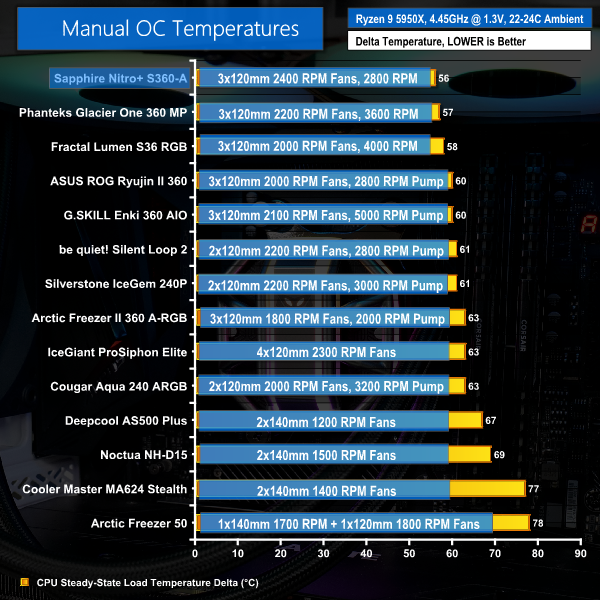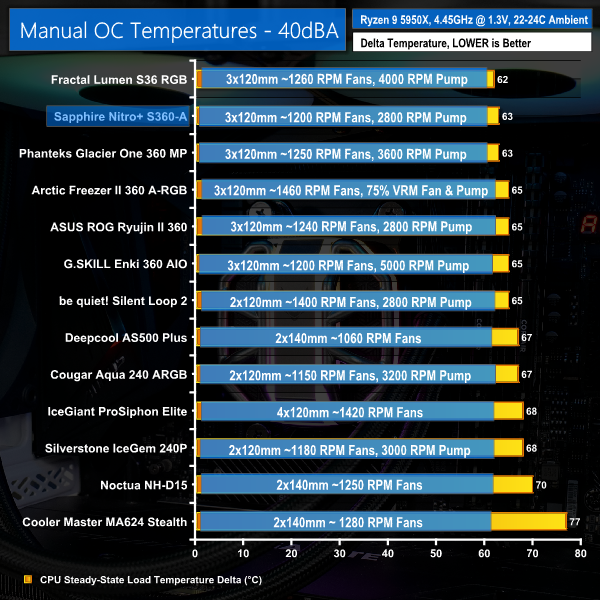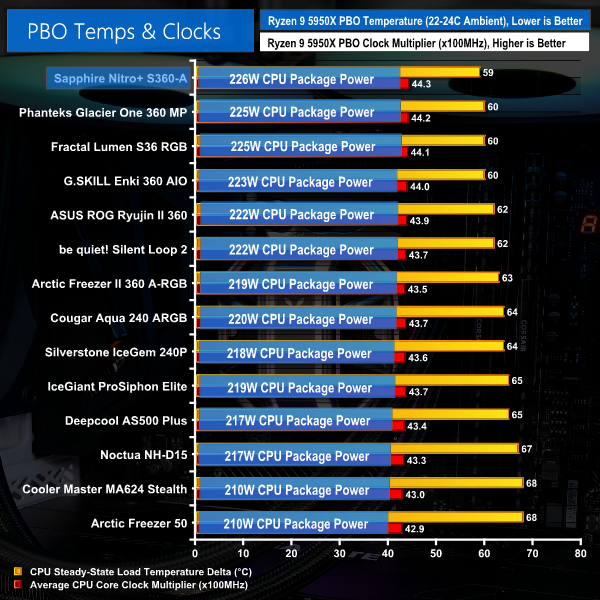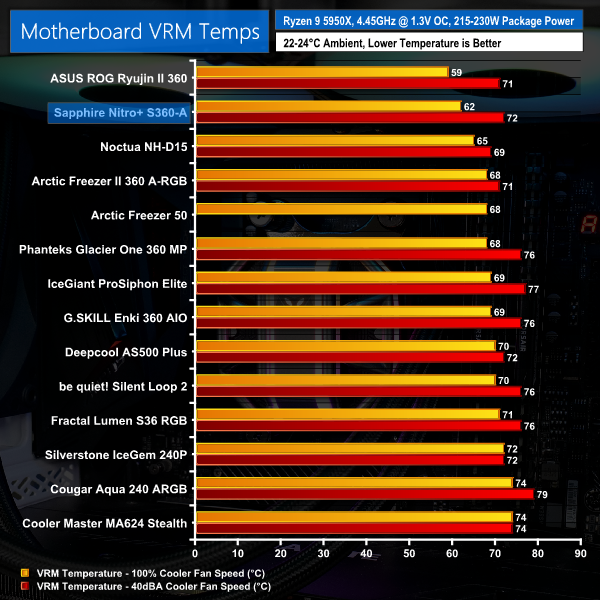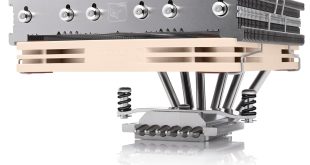Test System:
- Processor: AMD Ryzen 9 5950X
- Overclocked Settings: 4.45GHz all-core @ 1.312V (UEFI), Medium LLC – around 1.3V delivered
- Motherboard: Gigabyte B550 Aorus Master
- Memory: 32GB (2x16GB) Corsair Vengeance LPX 3600MHz 16-18-18-36 DDR4 @ 1.35V
- Graphics Card: Gigabyte RTX 2060 Super 0dB Mode
- Chassis: Fractal Design Meshify 2
- Chassis Fans: 2x140mm 1000 RPM Fractal Front Intake, 1x140mm 1000 RPM Fractal Rear Exhaust, 1x140mm 1000 RPM be quiet! Pure Wings 2 Roof Exhaust (for air cooler testing)
- Power Supply: Seasonic Prime TX-1000
- OS SSD: Corsair MP600 NVMe M.2 SSD
- Operating System: Windows 10 Pro 64-bit
Testing Methodology:
- For testing, we use a 30-minute looped run of Cinebench R23 and record the steady-state CPU temperature at the end of the test. This ensures that the CPU has had ample time to warm up and reach steady state under all of the coolers.
- Ambient is maintained around 22-24 degrees Celsius. Where there is variation beyond this temperature range, we add in extra repeated tests to ensure consistency.
- We also test each cooler with at least two fresh installs (typically three) to mitigate the likelihood of a dodgy mount spoiling results.
Test Results:
Acoustics
Noise output is… well… dreadfully high. This shouldn’t really come as a surprise with the Nitro+ S360-A using a trio of 2400 RPM fans and a 2800 RPM pump. With noise output levels that were actually quite irritating at full speed, we Sapphire will certainly need to deliver when it comes to cooling performance.
Of course, the fan speed range is 450-2400 RPM with PWM control. And the pump has speed control abilities too. So, this chart just highlights maximum noise output… which is really high!
In order to get the unit running at 40dBA, we had to crank the fans all the way down to 45% duty cycle.We left the pump at its full 2800 RPM speed as its proportion of noise output is not significant.
This 45% duty cycle registered as 1200 RPM on the fans, so there is plenty of headroom available if the cooler power needs ramping up.
Thermal Performance
I guess we now get the other side of the noise versus performance equation, and this is where Sapphire’s new 360mm AIO delivers exceptionally well.
Spinning its three 120mm fans at full speed, the Sapphire Nitro+ S360-A is able to position itself at the top of our overclocked Ryzen 9 5950X cooling chart. It does so by beating out another Asetek-based cooler with high-speed fans and a high RPM pump – the Phanteks Glacier One 360 MP.
Put simply, if you have a highly demanding cooling workload, such as an overclocked Ryzen 9 5950X putting out over 220W of heat, the Sapphire Nitro+ S360-A will deliver exceptional levels of performance. It is loud, but the performance is there in copious amounts
With the coolers locked to 40dBA noise output by reducing their fan speeds, we see some degree of cooling efficiency for the units tested.
Even with over half the speed cut off its fans, the Sapphire Nitro+ S360-A still does well at handling our overclocked Ryzen 9 5950X. But it cannot quite maintain its top-of-the-chart position. This time, Sapphire slots in just behind the Fractal 360 AIO and level with the Phanteks competitor.
This tells us that Sapphire’s choice of fan is very good in terms of noise efficiency, but not quite as strong as the 120mm blowers used by Fractal for example.
Firstly, it is critical to note that small difference in the displayed delta temperatures are not critically important for our PBO testing. The clock speed and cooling power achieved – when balanced against the reported temperature – are the important metrics.
Jumping back to full fan speed data with PBO testing, the Sapphire Nitro+ S360-A once again positions itself at the top of the chart. Yes, this is a case of Sapphire blasting its way above the other coolers with faster fans and therefore higher noise output. But that will be relevant to users who need that top-end cooling power when their processor’s heat output really ramps up.
Here, Sapphire’s Asetek-based cooler is very slightly better than the Phanteks competitor. This is by virtue of a minuscule increase in manager CPU package power and a minor increase to the associated chip frequency.
And now looking at VRM temperatures for our manually overclocked 5950X and Gigabyte B550 Aorus Master motherboard, Sapphire does exceptionally well… somewhat surprisingly.
Unsurprisingly, ASUS tops the chart thanks an equipped high-performance VRM fan on the pump-block unit. But Sapphire is only a few degrees behind and is notably above the Arctic Liquid Freezer II 360 with its less capable integrated VRM fan.
This is more nuanced than Sapphire’s high-speed fans simply blasting to the top of the chart, as proven by the data from the Phanteks competitor. Instead, it looks like the advertised Nitro+ Hybrid Fan Blade design is actually proving useful for enhancing VRM cooling with our specific chassis, positioning, and motherboard heatsink setup.
With the fans dropped down to 40dBA noise level, though, we do see quite a reduction in performance that puts Sapphire’s unit more in-line with the rest of our test pack.
 KitGuru KitGuru.net – Tech News | Hardware News | Hardware Reviews | IOS | Mobile | Gaming | Graphics Cards
KitGuru KitGuru.net – Tech News | Hardware News | Hardware Reviews | IOS | Mobile | Gaming | Graphics Cards


